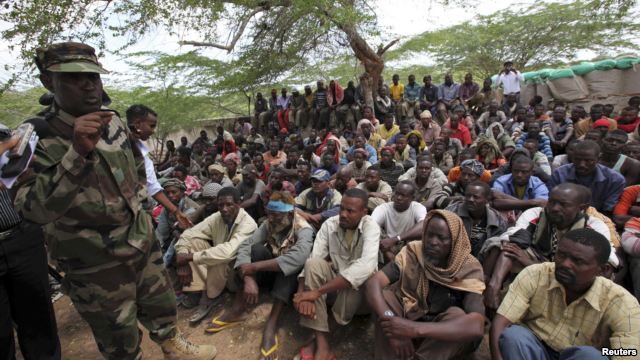
Friday, October 26, 2012
by Harun Maruf, Joe DeCapua

Members of al Qaida-linked militant group al Shabab listen to a Somalia government soldier after their surrender to the authorities in the north of Somalia's capital Mogadishu, September 24, 2012.
The militant group al-Shabab is losing ground rapidly to Somali government troops and allied Kenyan and African Union soldiers. Most recently, the group lost the key port town of Kismayo, which served as a strategic base and an important source of revenue. But despite the military setbacks, al-Shabab’s top leadership is holding together at least for the time being and the group is promising a long war.
The capture of Kismayo is sweet revenge for Sheikh Ahmed Mohamed Islam, also known as “Ahmed Madobe,” whose militia fought alongside Kenyan and Somali government forces. He is a former deputy leader of al-Shabab but was kicked out of Kismayo in November 2009 after his militia, Raskamboni, had a falling out with al-Shabab.
Madobe, a native of Kismayo, wanted an inclusive administration for the town, with representation for local clans. Al-Shabab insisted on a totalitarian style of governance - which Madobe says was the group’s downfall.
“They have media department, Jihad department and security," said Madobe. "They have many departments but those sections don’t have powers. They are sailing on boat navigated by someone else. Whoever raises questions about this gets killed. It is not an organization managed based on consultation among them people.”
Ahmed Madobe was a founding member of al-Shabab in August 2006. At the time Mogadishu and many areas in south-central Somalia were controlled by the Union of Islamic Courts (UIC). Jihadists in the group then accused the UIC leaders of not performing true Jihad.
In August 2006 the group secretly formed Harakat Mujahedeen al-Shabab (the Mujahedeen Youth Movement) or al-Shabab. Ahmed Madobe was elected as the deputy leader.
“After a long meeting we agreed to unite under a Jihadi system different from other systems," said Madobe. "We took the name al-Shabab. They proposed Ismail Arale, who studied in Pakistan, to be the leader and I was chosen the deputy on behalf of Raskamboni.”
The group attempted to establish a small Islamic emirate within in the UIC but this move was interrupted by the incursion of Ethiopian troops into Somalia. By late 2006, the UIC was routed and many of its leaders fled the country. In February 2007, Ahmed Madobe was wounded by U.S. airstrikes in the Lower Jubba region and subsequently captured by the Ethiopian troops.
Three months later in May, al-Shabab’s leader, Ismail Arale, was captured in Djibouti by CIA on his way to Eretria and sent to Guantanamo Bay, Cuba.
Al-Shabab reacted swiftly and replaced them both. Ahmed Abdi Godane, also known as Mukhtar Abu Zubayr, took the helm and remains the group’s emir.
How al-shabab operates
Al-Shabab is largely run at the whim of its leader. Abu Zubayr is a trained accountant in Pakistan where he crossed the border into Afghanistan in the mid-1990s and is believed to have had militancy leadership training.
Starting in 2008, the group seized control of city after city, and moved to impose a strict form of Islamic law in which music was banned and most international aid groups were not allowed to operate.
Meanwhile, the role of foreigners grew, and in February this year, al-Shabab formally joined al-Qaida. The group’s leader “Abu Zubayr” made the announcement in a message to the leader of al-Qaida, Ayman al-Zawahiri.
“To the respectful and honorable emir Sheikh Ayman al-Zawahiri, may God protect you," he said. "A message from your soldier, Mukhtar Abu Zubayr. Dear beloved emir, on behalf al-Shabab al-Mujahedeen, we hereby enter an agreement with you under the guidance of the holy book and hadith to listen to you and obey you in good and bad times both. Lead us the way to the Jihad and martyrdom as laid down by our martyred Imam, Sheikh Osama.”
But the merger came at a time when both groups were weakening, and experts believe it was just a symbolic move to energize their base.
Al-Shabab began losing ground to government and African Union troops in late 2010, and was weakened further by the drought that ravaged Somalia in 2011.
Lately, the group has found it difficult to put up a meaningful fight in a conventional war against the African Union force, known as AMISOM. The loss of Kismayo is a huge blow to al-Shabab financially and strategically. The group used the port to tax commercial goods and to export charcoal, a lucrative resource of revenue according to U.N. reports.
Far from finished
Nonetheless, experts believe Al-Shabab is far from finished. Dr. Roland Marchal, a senior fellow at the National Center for Scientific Research in France, believes the loss of Kismayo was a defeat in military and symbolic terms but not necessarily strategic one.
“The strategy of al-Shabab is first to secure new sanctuaries, and those sanctuaries will be located in rural areas far from roads," he said. "The strategy will then be to target logistical lines of AMISOM because now AMISOM is occupying a number of cities all over Somalia and not only Mogadishu. So the issue of logistics is becoming a nightmare. At the same time they will continue the same activities they have involved in terms of targeted killings, IEDs in cities and suicide bombings.”
It remains to be seen whether this strategy can turn the tide for al-Shabab, or whether the group is about to become a closed chapter in Somalia’s recent chaotic history.